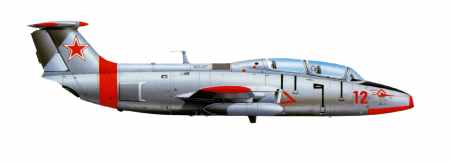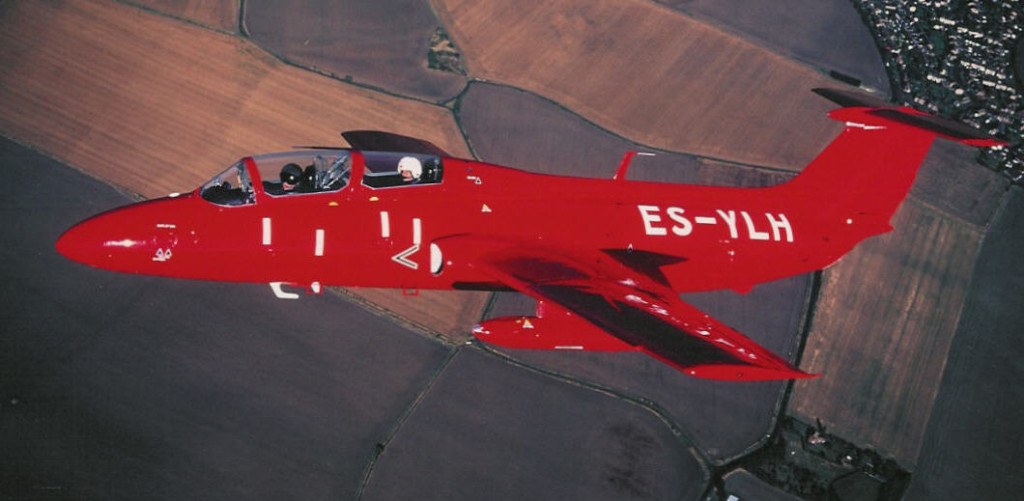Flying the L-29
History
 It was the early 1960’s. The Berlin wall was built, the cold war at its height and the USSR was looking for a basic jet trainer. Designs were submitted from the various satellite countries. The “Poles” proposed the TS-11 Iskra (still flying with the Polish A/F, one buzzed me in August whilst on a ferry flight!) Czechoslovakia the L-29 Delfin, and Russia the YAK 30. The Czechs won with the L-29, the first production aircraft was delivered in April,1963. In addition to the standard model, two others were produced in small numbers, the L-29R, available with nose cameras and underwing stores, and the L-29A, a single seat aerobatic version. Altogether, about 3,600 aircraft were completed by the time production at Aero’s Vodochody plant near Prague, ceased in 1974.
It was the early 1960’s. The Berlin wall was built, the cold war at its height and the USSR was looking for a basic jet trainer. Designs were submitted from the various satellite countries. The “Poles” proposed the TS-11 Iskra (still flying with the Polish A/F, one buzzed me in August whilst on a ferry flight!) Czechoslovakia the L-29 Delfin, and Russia the YAK 30. The Czechs won with the L-29, the first production aircraft was delivered in April,1963. In addition to the standard model, two others were produced in small numbers, the L-29R, available with nose cameras and underwing stores, and the L-29A, a single seat aerobatic version. Altogether, about 3,600 aircraft were completed by the time production at Aero’s Vodochody plant near Prague, ceased in 1974.
Approximately 3,000 were delivered to the Soviet Union; other customers included the Czech Air Force, the German Democratic Republic, Romania, Syria, Bulgaria, Hungary, Egypt, Indonesia, Nigeria, Uganda, Iraq.
The recent gulf strike was to knock out Sadam Husain’s chemical/ biological capabilities this included the L-29 that he had converted to a drone a/c for delivery of these weapons
The Delfin was operated by Dosaf in Russia and was the trainee’s first jet, most pilots having first gained experience in the Yak 18 or 52.
Even today all Soviet aircraft, have similar and cockpit layout of instruments and controls. The Delfin does not possess an abundance of power (about 1960lbs thrust as compared to a JP3 of 1700lbs) so like the YAK 11, takes a while to get going but when cleaned up and at operational speed it’s a nice little jet.
The L-29 then led the pilot onto the MIG 15/ 17 front line fighters of the day, the change over to these fighters being relatively easy allowing the student to concentrate on the performance differences and SOP’s of the new fighter.
The aircraft
Being of a totally new design (unlike the British concept at the time of putting a jet into the piston airframe of the provost) a tandem seating position was chosen with the best wing for subsonic flight, the straight wing. The wing has the ability to carry two of the following:- 150 lts drop tanks (normal use), 100 kg bombs, pods each containing four 67mm rockets or two pods of 7.62mm machine guns. While on the subject of explosive devices both cockpits have ejector seats for use up to 800 kph , a coloured flare system at the rear of the fuselage and a destructive charge in the nose to destroy the IFF unit.
The maximum speed with underwing stores is 0.7 mach and 0.75 without, while “G” limits being +8 -4 all this in an aircraft weighing just over 3,500 KGs. The empanage is the “T” tail much like the Paris Jet, in fact the Paris jet is much the same size but with 4 seats and is certified with a normal category C of A. an aircraft that is long forgotten I feel.
The fuselage has a single engine breathing from an intake in each wing root. This is mounted about mid way and towards the rear of the wing. The Motorlet M-701c-500 turbojet rated is at 1,960 lbs. thrust. The M-701 is an early generation jet engine and features a single stage centrifugal compressor driven by a single stage axial flow turbine. 100% RPM is 15,300, this gives a whistling sound a bit like the fouger magister of similar vintage. There are 7 combustion chambers mounted around the engine. (see photo)
Access to the engine for maintenance at 200 hrs requires the dismounting of the rear fuselage, this sounds a big job but it is facilitated by the removal of bolts in the tail surfaces control rods. A few electrical connections and eight bolts separate the fuselage. Time for this works is 2 persons 2 1/2 hrs. All other maintenance can be carried out through the access panels.
As with all other FSU aircraft the L-29 is made from anodised aluminium. This being the standard in the East as opposed to the Western philosophy of using Al clad materials. The difference being anodising chemically changes the surface to resist corrosion and Al clad is process that puts a thin coat of pure aluminium onto the surfaces. The exception to aluminium skinning is the rudder and elevators. These have a material that is high in magnesium. Magnesium is a material that will dissolve in water over time so it is not uncommon for these surfaces to show signs of corrosion. In fact these areas are the only ones that corrosion has been found on the aircraft imported so far. Beech in the USA went through a phase of using magnesium rich materials on tail surfaces also at about the same time. It represented a weight saving of 120 grams!!
Luggage space is very restricted with a small area in the noise section and soft bag stowage under the seat and a little bit tucked under the elbows on the consuls.
Flying the aircraft
P1 takes the front seat with the instructor in the rear seat who has duplicate controls and some simulated instrument failure switches and rear cockpit override controls. Seated in the front seat at the correct height, visibility is very good (assuming that the bomb/ rocket sight is removed) Instruments and switches are all very easy to reach with exception of the anti G suit test function behind your left elbow. The instructor has a reasonably good look out also with exception to the pilots head being in the way for forward looking. The forward visibility drops to zero whilst flying in rain so reverting back to the long ago learnt principle learnt flying tail draggers of looking sideways comes back into play whilst landing.
Pre flight checks are very simple with no ground support being necessary other than every 4th flight or so ground charging the pneumatic system that provides pressure to the canopy seals and brakes. Internal battery power is sufficient for starting but if available external power is preferred. The undercarriage, flap and air brake are powered by hydraulics. U/C and flaps have an emergency accumulator to blow these down if required. The accumulator has a residual pressure of 50 Bar nitrogen and is then charged with 100 Bar hydraulic oil pressure. Aileron, elevator and rudder controls are all simple manual push rods.
To start the engine is simplicity, battery on, ignition on, push start button 3 sec’s, release and open fuel cock. Watch RPM, pressures and EGT 30 sec’s later idle speed is 40% then power up the remainder of the electrical systems, generator on and gyros etc.
Taxying is straight forward if you have YAK 52 flight time!! With nose wheel castering, steering is by differential braking from a brake lever on the stick. Apply rudder in the direction of turn with the necessary braking action and the a/c will turn. Quite high power is needed if trying to turn tight from a parked position so watch out for jet blast damage to objects to the rear of the a/c. Once on the move small applications of brake keep you going in the right direction.
The canopies seal for the air conditioning and pressurisation, temperature is either automatic or manual hot/ cold. Cabin pressure can be maintained with a 5-7,000ft differential this makes flight up to 15,000 ft without oxygen a possibility. From there on oxygen is needed and this is supplied from 3 bottles and an emergency reservoir in the seat pack. However flight in the UK at these altitudes is probably not very common! Seals also makes the cockpit noise quieter than most piston types.
Lining up on the runway, flaps set 15′, T’s and P’s power check and roll, (mental check on abort/ stop distances) the take off roll is not the wild acceleration of the modern fighter. Lift off will be 25 sec’s later, clean up and establish initially 250 kph into the climb allowing this to increase to 300 kph this being best rate of climb giving about 2300fpm depending upon weight and temperature. Raising the flap electrically re-trims the aircraft so a small oscillation is felt through the controlsOnce in level fight speeds again vary with temp/ weight / altitude but at 92% power will normally give about 400- 450 kph indicated.
Flaps are the slotted fowler type having a pitot pressure switch that prevents operation outside the limiting speed of 290 kph, they automatically retract above this speed then extend below this speed if selected. Whilst talking about automatic functions the air brake auto extends if the mach limit of 0.7 is reached also the action of selecting gear up automatically applies brakes to stop the wheels from turning in the wheel wells.
Once clear of any ground turbulence the ride is so relaxing, with no vibration, or bumping around. Watching the world go by is surreal, fluffy white clouds below with a cobweb of roads and towns on the picturesque patchwork of today’s farmland.
Now for general handling. The straight wings give a very honest stall and no tendency to drop a wing, initially buffet is felt then just keep pulling the stick back until the stall is reached at approximately 140 kph depending upon weight, the nose will drop and normal recovery action is taken, except with a jet the engine response (spool up) from full idle to 100% power takes 12 seconds. The aircraft is cleared for both erect and inverted spinning. But the CAA know better than the designers and manufactures preventing spinning on the UK permit to fly.
Aerobatics are just great fun. Dive to 700 kph (377kts) and pull 3 1/2 G ; the loop will be 5,000 ft diameter as can be appreciated the pull will last for ever and the correct breathing style needs to be practised to resist the G for when you want to start pulling tighter corners. As previously mentioned all controls are manual and this helps with G control. Pulling 6 G really is very physical with both hands needed on the stick, pull hard, tense hard = no grey out!! Rolls with up to 3/4 aileron can be done with one hand but during a display if I want to get the quickest roll rate I will use both hands. The rate of roll is about 120′ second.
The aeroplane makes a very solid instrument platform and it is easy to make small pitch and roll adjustments with no tendency to over control. Unlike the YAK 52, the AI shows in what we in the West call the “correct sense”
I mentioned the G suit controls earlier, when using anti G trousers physically managing this high G thing really is simple. At about 1 1/2 G the trousers start to inflate and restrict the blood flow to the legs preventing all the blood in the upper body from “escaping” leaving enough to keep the brain fed and remain conscious. Just a pointer if at any time during aerobatics (whatever the aircraft) your vision starts to grey in from the sides tense harder and if that does not work relax the stick pressure. For an instant “I am awake” roll inverted! Now you might say “what happens if I am pointing at the ground”. Well relax the stick and fly to miss the ground. If you can’t do that remember sight goes first, then sound and then consciousness. You will be able to fly in this “grey area” to save your life as a last resort.
Joining the circuit
I used to watch jets doing a “run and break” and thought “show off” but now having flown them I now know the reason. Basically it makes landing and flying the pattern easier. It is the quickest way of getting the a/c onto the ground especially if you have to recover a formation. Fly past (on runway landing heading) at 450 kph and at mid point turn for down wind pulling 4 G, closing the throttle, speed brakes out for 10 sec’s until ASI is at 290 kph and select gear down, at 270 kph 15′ flap, start to spool up engine and maintain 240 kph into base leg selecting 30′ flap continue the turn onto finals not below 220 kph then once established 200 kph, if you judge this correct the circuit will be the same (or smaller) as the GA traffic pattern.
Speed brakes are deployed by either a switch on the throttle or temporarily by pressing a button on the stick. The landing is very easy just hold off with very little flare and you’re down. For a touch and go I would suggest that a minimum runway length of 1500 metres but for full stop landings 1000 metres is sufficient.
PPL in a Jet!
Jet flying in the UK is regulated by the CAA under CAP 632, basically this document will provide for the training, maintenance and operation of the aircraft. So the L-29, like so many other single engine jets of less than 5,700 KGs MTWA, can be flown with a standard PPL. CAP 632 will ensure that proper training on type is taken before going solo.
For example a 100 hrs Cessna 172 pilot has just purchased the L-39. No magic just the cost!
Costs
Well for this unique fun there is a price to pay. The aircraft will cost you about £50-60,000 with a UK permit to fly. Buying prices start at around $60,000 from the FSU. Fuel consumption is approximately 800 lts per hour , low and fast. Jet A1 prices vary greatly from one airport to another. For example Stansted is 8.5p/ lts and Cranfield 27p/ lts so £68 to £216 per hour in fuel. Most other airports being around the 20p (£160/hr) add to this maintenance and to budget on the safe side £250 per hour. If buying an aircraft get one with a low time engine (TBO is 500hrs) most of the UK operators have a spare engine in stock, these only cost £7,000!
Where to buy
The Russian Jet Co in Lithuania (00 370 49 52804 fax ) have aircraft ready to “Go” with C of A at most times having already supplied 2 aircraft to the UK. These have both been flown back by myself using the tried and tested routes/ airports we use for ferrying YAK 52s. Acceptance flights take place in Lithuania then head West, not before all overflights permissions, extra German insurance and a/c papers have been checked I might add. The owner has flown back seat on both occasions gaining valuable flight experience. In addition to their own aircraft Phill Greenhalgh has bought 2 aircraft into the UK.
With 5 of these aircraft now in the UK, expect to see them at airshows and fly-ins and, who knows, soon there may be a squadron of them. And finaly a quick note for the locals at Gransden, these aircraft will not be flying from here.
Specifications:
Engine Motorlet M-701c-500 rated at 1,960 lbs thrust
Wingspan 33 ft 9 in
Length 35 ft 5 in
Height 10 ft 3 in
Fuel Capacity 1030 lts internal, 300 lts divided in two external tanks
Maximum T.O.W. 3,539 KGs
Max load factor +8/-4
Vmo .7M
Vne 800 Kph (432 Kts)
Takeoff run 1,805 ft at sea level
Landing distance 1,444 ft
S.L. rate of climb 2,300 fpm
Stall Speed landing config 125 Kph light, 155 Kph heavy, 30′ flap
Max speed at S.L. 97% 575 kph. Or 620 kph @ 100%
Ceiling 36,000ft

